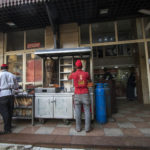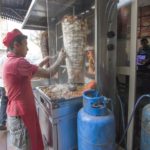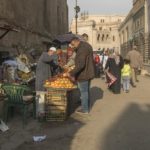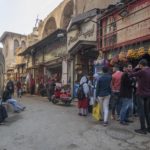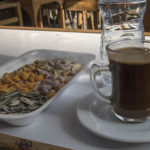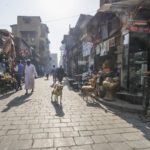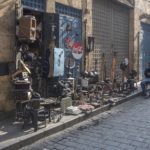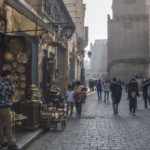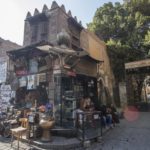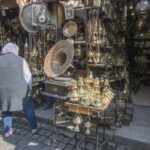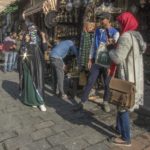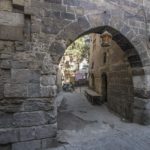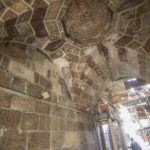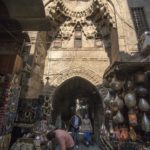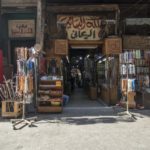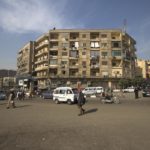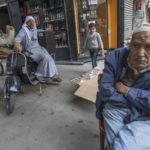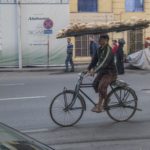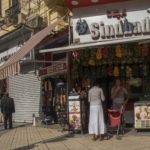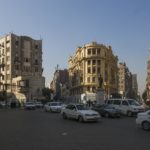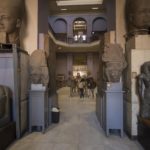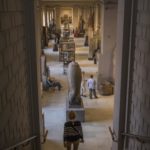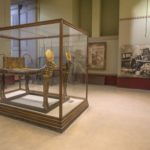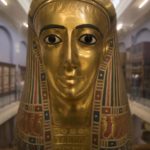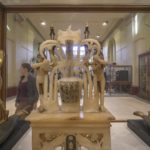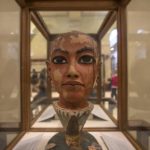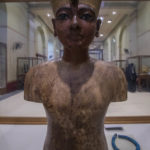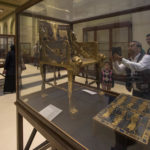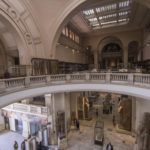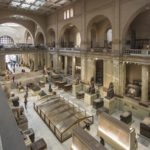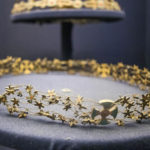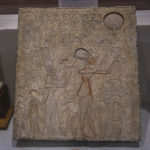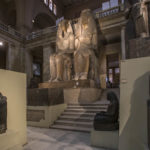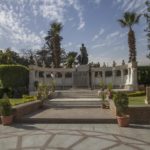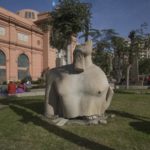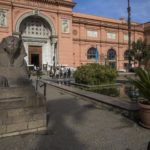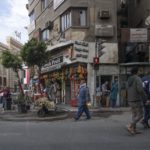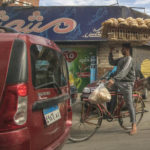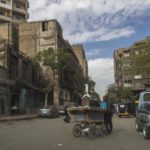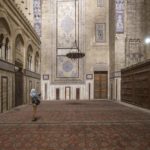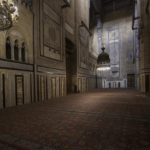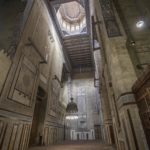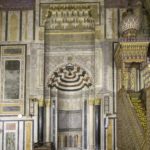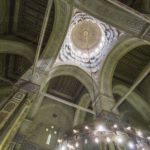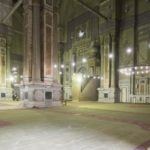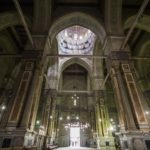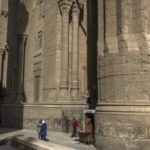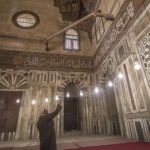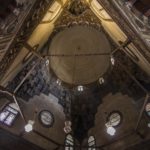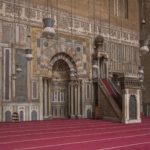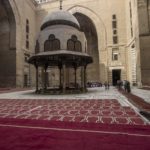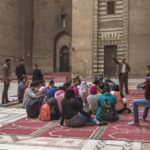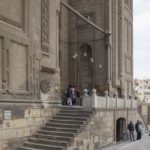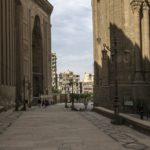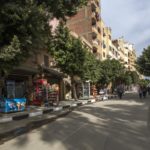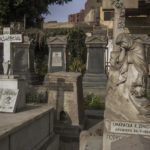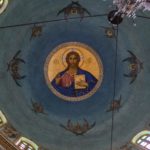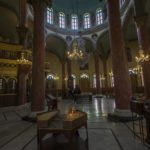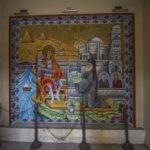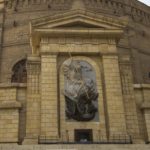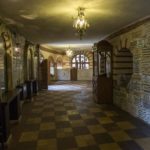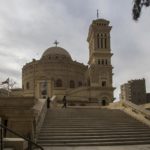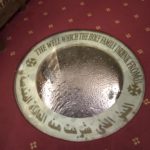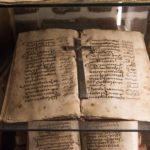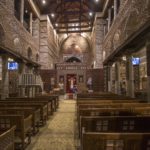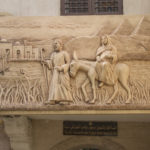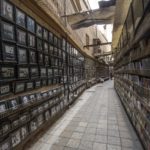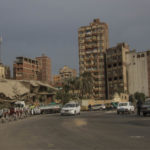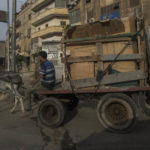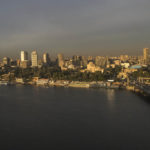Coptic Cairo
We began our further explorations of the nation’s capital by heading directly to the Coptic Cairo area. Ayman collected us at 8:30am and we were greeted by Monday morning Cairo traffic, which was a ramped up version of the weekend traffic!
We found a parking spot and right in front of us was a building nearly fully collapsed, as though there had been an earthquake. In reality, it was a dodgy build. Ayman said that for about six months after the 2011 revolution, rules and regulations for construction were non-existent and therefore cheap and dangerous buildings went up everywhere. Nearby, another building, this time six stories high, had a definite lean to it – the foundations were not strong enough to support the structure (and yet people were still living in it!).
Coptic Cairo was down a narrow street blocked off to traffic – its slim thoroughfare used to cause huge problems when buses and other vehicles attempted to navigate it. We headed down below street level and into the area once inside the medieval city walls. Only about 12 people live inside this small section of the city now, mainly due to the dilapidated state of the place.
Our first visit was to Saints Serbius and Bacchus Church, where the holy family stayed when they were in Egypt. It was a beautiful and charming church with exposed red brick and a roof supposedly made of Noah’s ark (only upside down). Framed in white marble with embossed lettering in gold, was the well from which the holy family apparently got their water. The words in English have a bit of corrected grammar in gold as well – “drunk” has been altered to “drank”!
A short distance away was St Virgin Mary’s Coptic Orthodox Church, also known as the ‘Hanging Church’. Its nickname has nothing to do with executions, but rather the church itself is suspended on gigantic beams above a gatehouse of Babylon Fortress. It is one of the oldest churches in Egypt and a history of having a church on this site dates to the 3rd century AD. No photos were allowed, but of course there were still three people in an antechamber ignoring that instruction.
The motif of churches continued with Greek Orthodox St George’s Church. The church dates back to the 10th century, but the current structure was built in 1904 after a fire. Apparently, locals believe that St George was tortured here for three years (or some such) and never bled. According to Ayman, these are all folklore stories, as there is no evidence that he was ever there.
A cemetery was attached to the grounds of this church, and it looked like a miniature town or a film set. It ran along the main street, but locals insisted that a wall be built so that they didn’t have to “see it”! The fact that it can still be seen from the first floor and above of every building in the vicinity seems to matter naught.
Islamic Cairo
Without Ayman to guide us, we would not have had a clue about what to see and what to cull in these areas of historical significance in Islamic Cairo. He chose for us two impressive monuments at the foot of the Citadel – Mosque-Madrassa of Sultan Hassan and the Mosque of Al-Rifai.
Mosque of Sultan Hassan was built in the 14th century and at the time of construction was considered remarkable for its size and architectural components. It is now a school of instruction in Islam (a madrassa) as well as a mosque and mausoleum, and on our visit we saw pockets of people throughout, studying, visiting, preparing to pray. The most memorable moment of our visit was being invited by the imam to stay with him in the mihrab as he sent out the call to prayer, and then explained to us the text of the Koran that lined the walls of the room.
Directly next to the Mosque-Madrassa of Sultan Hassan was the Mosque Al-Rifai (also known in English as the Royal Mosque). It was constructed in two phases between 1869 and 1912 when it was completed. The vision for the building was dual – as a place to house Sufi relics and as a mausoleum for the royal family of Egypt. We managed to explore for a brief time before the afternoon closing, lucky that it was a short experience or neck massages would’ve been required from all the craning to see the glorious architecture overhead.
Egyptian Museum
The Egyptian Museum is situated in the centre of Cairo, walking distance from our hotel, the InterContinental Cairo Semiramis. Once a palace, the terracotta-pink structure, with its front garden of ponds, plants and statues, is an appropriate house for the historic wealth of Tutankhamun. But as Egypt’s archaeologists continue to discover artefacts all over the country, this little spot is now bulging at the seams.
In 2002 the foundation stone was laid in Giza for the Grand Egyptian Museum, with construction starting ten years later in 2012. On our visit to Egypt it was still incomplete, but they hope to partially open by the end of 2018. The current 136,000 exhibits in the Egyptian Museum (and additional 40,000 items in the basement) will certainly be more spaciously arranged in their new home.
For now, visitors have to make do with the current building, where even 4 hours is only enough time to begin explorations. There was a dizzying amount of antiquities and artefacts to pour over, but we were very grateful to have our guide, Ayman, to direct our focus, otherwise it would’ve been overwhelming. Of course, our favourite items were all about Tutankhamun, especially the solid gold burial mask, the image of which is recognised the world over. Photographs were not allowed in this section of the museum, but there are plenty of pics online to look at. Although nothing prepares you for the real thing, which was beyond all superlatives in its beauty, grandeur and mystique!
Downtown Cairo and Old Market
Due to a hideous battle with my insides, I did not venture from the hotel room on our final day in Cairo. Once again, Ayman came to my rescue with the recommendation of a fantastic little drug called Antinal – a local pharmaceutical designed for the local ‘bugs’. It certainly did the trick, and within 24 hours I was back out there enjoying my holiday. The over the counter meds cost us $2 AUD, and it saved us the $100 USD for a hotel doctor house call.
John and Ayman explored Downtown Cairo without me, making the mandatory coffee shop stops throughout their day. Here is John’s account of their day:
“With Nicole medicated and resting I set out with Ayman, walking through Tahrir square and on through the downtown area.
Reminiscent of Parisian architecture with its embellished facades, avenues and statues, there was a distinctly European flavour to these boulevards, constructed in the nineteenth century. The grandeur of that time still showed despite the occasional building in need of maintenance. This was the scene of tumultuous times with revolution in the streets after WWI against British occupation, and then again in 1952 when the fires and riots resulted in Independence. 1992 saw an earthquake that devastated the city and 2011 had the streets filled with millions calling for the resignation of Mubarak.
After an interesting stroll through life as it is lived in the big city we drove to the Old Town to experience medieval streets that followed high walls and were crowded with a glitter of stalls packed with merchandise to catch the eye. Groups of students clearly on an excursion were trying on traditional garments while their mates took selfies. A magnificent archway led to fresh produce, arrays of antiques and a marvellous choice in sheesh pipes.
Beyond all this we stayed a while at a coffee shop favoured by Ayman because of its coffee, its owner and the people-watching you could do while drinking the coffee, nibbling the snacks and talking about solving the world’s problems. Conversations like this you don’t get in a tourist guidebook; nor the to-do between the owner of the coffee shop next door and a lady trying to sell things to his customers. While it didn’t come to blows, there were pointed words and raised voices that subtly affected everyone in hearing in this very public place. No doubt all picked sides but there was something of a calm choreography of passions that made this seem like a passing weather pattern rather than impending strife. Violent words vented, she moved on and the ambience settled to its regular buzz.
This was a wonderfully immersive and relaxing way to see and appreciate the patterns and spirit of life as it ebbed and flowed in this part of the city, while being reminiscent of life ‘back home’ nevertheless had its own character that had been formed and developed over millennia.”
And so our time in Cairo came to an end. We were not yet ready to move on, and our reluctance was due not only to the unexplored wonders of the city, but the friendship we had made with our guide Ayman. To be a guide in Egypt takes four years of training, with the maintenance of accreditation being determined every two years by a two-week ‘test’. When working, if a guide is stopped by authorities and does not have a current licence, he will face a hefty fine and possible goal time. We were so very lucky to have discovered our specialist – archaeologist, passionate historian, pedagogue and fantastic human. If only we had found him before arranging other components of our itinerary, as we so wished he was continuing with us on our journey south to Luxor.
Our Egypt adventure continues in Luxor…
Accommodation: InterContinental Cairo Semiramis [See here for a detailed account of our time at the Semiramis.]
Tour Guide: Ayman Ahmed Tour Guide and TA Reviews
Read our full Cairo story here:
Part 1: Memphis, Saqqara & The Great Pyramids
Part 2 (current): Coptic Cairo, Islamic Cairo & Egyptian Museum
Click on any image below to view as gallery
- Gad store, Cairo
- Gad kebab, Cairo
- Buying oranges, medieval Cairo
- Street scene, medieval Cairo
- Coffee and snacks in medieval Cairo
- Dog in medieval Cairo
- Man and his shop, medieval Cairo
- Street in medieval Cairo
- Corner store in medieval Cairo
- Gramophone at the Old Market, Cairo
- Local teens dressing up for selfies, Cairo
- Old archway, Cairo
- Stonework ceiling of city wall, Cairo
- Medieval gate, Cairo
- Shop front, Cairo
- Cairo apartments
- On the street, Cairo
- Perfectly balanced bread delivery, Cairo
- Sinbad, Cairo
- Downtown Cairo
- Chock full of treasures, the lower floor, Egyptian Museum, Cairo
- To the lower floor collection, Egyptian Museum, Cairo
- Formal chair from Tutankhamun’s Tomb, Egyptian Museum, Cairo
- Golden head, Egyptian Museum, Cairo
- Marble chair, Egyptian Museum, Cairo
- Clay head of Tutankhamun, Egyptian Museum, Cairo
- Bust of Tutankhamun Egyptian Museum, Cairo
- Funerary chair, Egyptian Museum, Cairo
- One of the many sarcophagi in the Egyptian Museum, Cairo
- Upper floor, Egyptian Museum, Cairo
- View of the atrium from the upper floor, Egyptian Museum, Cairo
- Gold diadem, Egyptian Museum, Cairo
- Plaque of Akhenaten, Nefertiti and children, Egyptian Museum, Cairo
- Statues of Akhenaten’s parents, Amenophis III and Queen Tiy, Egyptian Museum, Cairo
- Memorial to Auguste Mariette, Egyptian Museum
- Fragments of antiquities, Egyptian Museum garden, Cairo
- Front of the Egyptian Museum, Cairo
- Street corner, Cairo
- Bread delivery, Cairo
- Crossing the road, central Cairo
- Nic taking photographs in the Mosque Al-Rifai, Cairo
- Lotus flower carpet in the prayer room for women, Mosque Al-Rifai, Cairo
- Ceiling of the prayer room for women, Mosque Al-Rifai, Cairo
- Prayer rug, Mosque Al-Rifai, Cairo
- Ceiling of the dome, Mosque Al-Rifai, Cairo
- Plenty of room for the faithful, Mosque Al-Rifai, Cairo
- Magnificent interior of Mosque Al-Rifai, Cairo
- Side door entrance to Mosque Al-Rifai, Cairo
- The imam explaining the words of the Koran at Mosque-Madrassa of Sultan Hassan, Cairo
- The ceiling of the mihrab, Mosque-Madrassa of Sultan Hassan, Cairo
- Ornate wall in Mosque-Madrassa of Sultan Hassan, Cairo
- Courtyard of Mosque-Madrassa of Sultan Hassan, Cairo
- Lesson in Mosque-Madrassa of Sultan Hassan, Cairo
- Entrance of Mosque-Madrassa of Sultan Hassan, Cairo
- Paved street between the mosques, Islamic Cairo
- Street in Coptic Cairo
- Cemetery of St George’s Church, Cairo
- Ceiling of St George’s Church, Cairo
- Interior, St George’s Church, Cairo
- Mosaic at St George’s Church, Cairo
- St George and the dragon, St George’s Church, Cairo
- Corridor, St George’s Church, Cairo
- St George’s Church, Cairo
- The well in Saints Serbius and Bacchus Church, Cairo
- Old manuscript, Saints Serbius and Bacchus Church, Cairo
- Interior of Saints Serbius and Bacchus Church, Cairo
- ‘To Egypt’ plaque, Coptic Cairo
- Books and photos for sale, Coptic Cairo
- Leaning and collapsed building, Cairo
- Donkey-drawn cart, Cairo
- Good morning, Cairo

